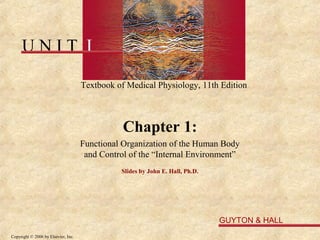
1.functional organisation of human body and the control of t
- 1. UNIT I Textbook of Medical Physiology, 11th Edition Chapter 1: Functional Organization of the Human Body and Control of the “Internal Environment” Slides by John E. Hall, Ph.D. GUYTON & HALL Copyright © 2006 by Elsevier, Inc.
- 2. Physiology The science that is concerned with the function of the living organism and its parts, and of the physical and chemical processes involved. • Human Physiology Copyright © 2006 by Elsevier, Inc.
- 3. Pathophysiology • The study of disordered body function (i.e. disease) • The basis for clinical medicine Copyright © 2006 by Elsevier, Inc.
- 4. The Human Body - A Complex Society of Differentiated Cells • Cells: the basic structural and functional unit (~ 100 trillion) • Tissues: (e.g. muscles, epithelial, nervous ) • Organs: (e.g. kidney, heart, liver, pancreas) • Organ systems: (e.g. cardiovascular, urinary) Copyright © 2006 by Elsevier, Inc.
- 5. Regulation and Integration • Exists at all levels of organization • Cells: e.g., genes, operons, repressor proteins, transcription factors, membrane transport • Tissues: e.g., autacoids, paracrines • Organ systems: e.g., nervous and endocrine systems Copyright © 2006 by Elsevier, Inc.
- 6. Homeostasis The maintenance of a stable “ milieu interieur” Claude Bernard (1813 - 1878) Copyright © 2006 by Elsevier, Inc.
- 7. General Organization of the Circulatory System Figure 1-1; Guyton & Hall Copyright © 2006 by Elsevier, Inc.
- 8. Exchange Between the Capillaries and Interstitial Fluid Figure 1-2; Guyton & Hall Copyright © 2006 by Elsevier, Inc.
- 9. Feedback Control • Negative feedback: promotes stability • Feed-forward: anticipates change • Positive feedback: promotes a change in one direction, instability, disease Copyright © 2006 by Elsevier, Inc.
- 10. Negative Feedback Control of Arterial Pressure Promotes Stability Art. Pressure Sympathetic Activity Heart Rate Vasoconstriction Copyright © 2006 by Elsevier, Inc.
- 11. Baroreceptor Reflex : Negative Feedback System - Promotes Stability Set-point Error signal Effectors + Vasomotor Sympathetic Blood vessels, Centers System Heart Controlled Sensor Variable Blood Baroreceptors Pressure Copyright © 2006 by Elsevier, Inc.
- 12. Cardiopulmonary Reflexes: Feed-Forward Control of Blood Pressure – Anticipates a Change Cardiopulmonary Cardiopulmonary Receptors Pressures Set-point + Error signal Effectors Vasomotor Sympathetic Blood vessels, Centers System Heart Controlled Sensor Variable Blood Baroreceptors Pressure Copyright © 2006 by Elsevier, Inc.
- 13. Feedback Gain A measure of the effectiveness of a feedback system Correction Gain = Error Copyright © 2006 by Elsevier, Inc.
- 14. What is the feedback gain in this example ? Hemorrhage 1.5 liters 100 Arterial Pressure “ error ”= + 25 75 feedback = - 25 50 “correction” Correction - 25 Gain = = = - 1.0 Error 25 Copyright © 2006 by Elsevier, Inc.
- 15. Feedback and Feed-Forward Control • Negative feedback: promotes stability • Feed-forward: anticipates change • Positive feedback: promotes a change in one direction, instability, disease Copyright © 2006 by Elsevier, Inc.
- 16. Positive Feedback of Hemorrhagic Shock Figure 1-3; Guyton & Hall Copyright © 2006 by Elsevier, Inc.
- 17. Hemorrhagic Shock: Positive Feedback Severe Hemorrhage Venous Return + Cardiac Output Blood Pressure Coronary Blood Flow Cardiac Contractility Copyright © 2006 by Elsevier, Inc.
- 18. Action Potential: Positive Feedback Cell Depolarization + Cell Na Permeability Na Influx Cell Membrane Potential Copyright © 2006 by Elsevier, Inc.
Notas do Editor
- Physiology is the science that is concerned with the function of living organisms and its parts, including the physical and chemical processes involved. In this course, we will be concerned mainly with human physiology, although as we will see much of our knowledge of human physiology is based on experimental studies in animals.
- We will also be discussing, to some extent, pathophysiology which is the study of disordered body function, or disease, and is the basis for clinical medicine. We will not have as much time as we would like in this course to discuss the pathophysiology of disease. This will be covered in the 2 nd , 3 rd , and 4 th years of you medical training, but we will throughout the course use clinical examples of pathophysiology to help illustrate physiological functions.
